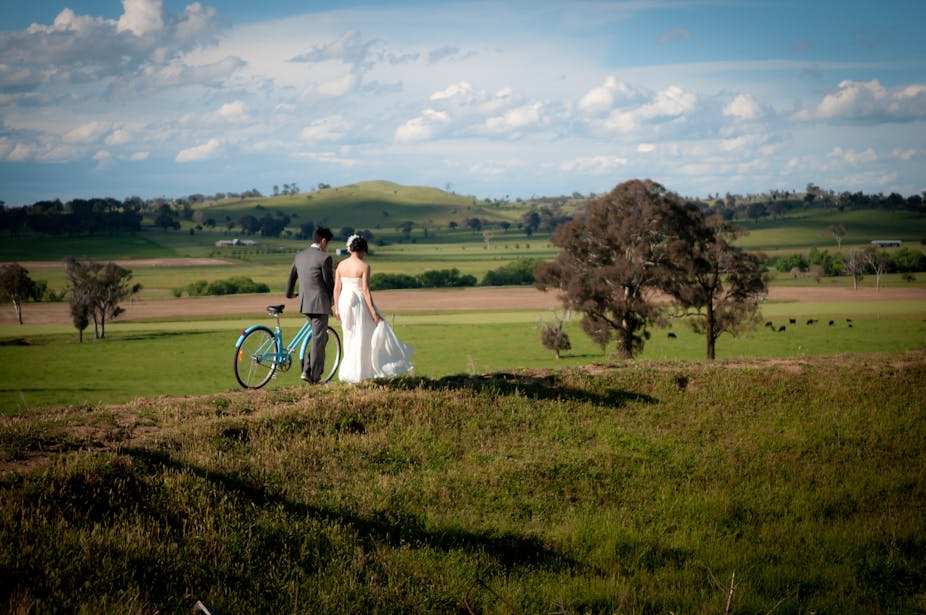AUSTRALIA BY NUMBERS: The Australian Bureau of Statistics has released the first batch of its census data. We’ve asked some of the country’s top demographers and statisticians to crunch the numbers on Australia’s population: how we live, where we work, who our families are and how we spend our time.
Here, Genevieve Heard has a look at the institution of marriage. Is it still relevant to Australians? The data says yes.
As the issue of access to marriage in Australia continues to fuel social and political debate, it is timely to reflect on the vitality of the institution. Newly released data from the 2011 census permit just such an assessment.
For decades, we have heard that marriage is on the wane, in Australia and across the secular West. The true picture is somewhat more complex.
The married minority
Certainly, the married proportion of the total population has been falling. It is no longer the case that a majority of the population is married.
In 2011, 49% of Australians aged 15 and over were in a registered marriage, down from 51% in 2001. Taking a longer view, the married proportion was as high as 64% during the mid-20th century marriage boom. Although this peak was historically unusual, we must go back to 1901 to find another census year in which the married population was less than half the total population aged 15 and older.
The proportion of marriages has fallen in all age groups up to and including 65–69 years. Slightly increased proportions among those aged 70 years and older may reflect continuing improvements in life expectancy and partner survival, rather than any change in propensity to marry.
The decrease among Australians aged 50–54 years and 55–59 years has been greatest — more than three percentage points since 2006, and seven percentage points since 2001.

Popular partnerships
So the proportion of Australians who are married has been falling across successive census years, but does this really measure the popularity of marriage? After all, the census is merely a snapshot of the Australian population at one point in time, and of those who were married at this point in time.
It can be more instructive to consider proportions ever married (counting those who indicated they were separated, divorced or widowed, as well as those who were married).
These data testify to the continuing popularity of marriage. At the 2011 census, the proportion ever married exceeded 70% at 35–39 years of age, exceeded 90% at 55–59 years, and peaked at 96% among those aged 75-79 years, 80-84 years and 85 years or more.
To a large extent, the figures for older Australians reflect the marriage trends of decades past, rather than recent trends. Nevertheless, it is difficult to argue that marriage is on the wane when the institution remains the dominant partnership model for adult Australians.
The rise of de facto relationships
It may be more accurate to claim that Australians are spending less time within the institution of marriage.
This is because we are marrying later, and are not necessarily remaining married for life. The proportion of Australians who were separated or divorced has remained stable over the decade to 2011, at 11%.
Of course, many Australians — almost 10% of those aged 15 years and over in 2011, compared to 7% in 2001 — live in de facto marriages, or cohabiting relationships. The prevalence of cohabitation varies greatly by age group, peaking at 22% among those aged 25–29 years.
This category includes same-sex as well as opposite-sex partnerships (this was not the first time that same-sex relationships were enumerated, but it was the first time same-sex couples were able to describe their partners as “husband” or “wife”).
Settling down, living apart
The continuing increase in proportions cohabiting offsets the continuing decrease in proportions married, such that the overall proportion of Australians living in any kind of residential partnership has remained steady at 59% over the past decade.
Proportions living with a partner are highest at ages 35–39 and 40–44 years. Even so, one quarter of Australians in these age groups are not living with a partner. In the group aged 30–34 years, over 30% are not living with a partner.
We know that some of these have previously been married, and we cannot tell how many have previously lived in de facto marriages. Many, however, have simply delayed family formation beyond the ages at which young adults were once expected to “settle down”.
Finally, it is important to note that the census does not capture all committed relationships or self-defined partnerships. Specifically, those in “living-apart-together” relationships — those who identify themselves as being in a relationship with someone who does not reside in the same household — are effectively hidden. This proportion has been estimated at 9% of the adult population, or 24% of those who were not cohabiting or married.
The census cannot tell us everything about contemporary Australian partnerships, but it reveals much. For better or worse, marriage remains relevant to most Australians — at some stage.

